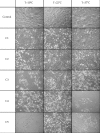Effects of temperature and doxorubicin exposure on keratinocyte damage in vitro
- PMID: 18193326
- PMCID: PMC2277440
- DOI: 10.1007/s11626-007-9074-9
Effects of temperature and doxorubicin exposure on keratinocyte damage in vitro
Abstract
Cancer chemotherapy treatment often leads to hair loss, which may be prevented by cooling the scalp during drug administration. The current hypothesis for the hair preservative effect of scalp cooling is that cooling of the scalp skin reduces blood flow (perfusion) and chemical reaction rates. Reduced perfusion leads to less drugs available for uptake, whereas the reduced temperature decreases uptake of and damage by chemotherapy. Altogether, less damage is exerted to the hair cells, and the hair is preserved. However, the two mechanisms in the hypothesis have not been quantified yet. To quantify the effect of reduced drug damage caused by falling temperatures, we investigated the effect of local drug concentration and local tissue temperature on hair cell damage using in vitro experiments on keratinocytes. Cells were exposed for 4 h to a wide range of doxorubicin concentrations. During exposure, cells were kept at different temperatures. Cell viability was determined after 3 d using a viability test. Control samples were used to establish a concentration-viability curve. Results show that cell survival is significantly higher in cooled cells (T < 22 degrees C) than in non-cooled cells (T = 37 degrees C), but no significant differences are visible between T = 10 degrees C and T = 22 degrees C. Based on this result and previous work, we can conclude that there is an optimal temperature in scalp cooling. Further cooling will only result in unnecessary discomfort for the patient and should therefore be avoided.
Figures


References
-
- {'text': '', 'ref_index': 1, 'ids': [{'type': 'DOI', 'value': '10.1016/S1471-4914(01)02027-5', 'is_inner': False, 'url': 'https://doi.org/10.1016/s1471-4914(01)02027-5'}, {'type': 'PubMed', 'value': '11425637', 'is_inner': True, 'url': 'https://pubmed.ncbi.nlm.nih.gov/11425637/'}]}
- Cotsarelis, G.; Millar, S. Towards a molecular understanding of hair loss and its treatment. Trends Mol Med. 7(7):293–301; 2001. - PubMed
-
- {'text': '', 'ref_index': 1, 'ids': [{'type': 'PubMed', 'value': '9655898', 'is_inner': True, 'url': 'https://pubmed.ncbi.nlm.nih.gov/9655898/'}]}
- Decorti, G.; Peloso, I.; Favarin, D.; Klugmann, F.; Candussio, L.; Crivellato, E.; Mallardi, F.; Baldini, L. Handling of doxorubicin by the LLC-PK1 kidney epithelial cell line. J Pharm Exp Ther. 125(1):832–840; 2003. - PubMed
-
- {'text': '', 'ref_index': 1, 'ids': [{'type': 'DOI', 'value': '10.1007/BF01404408', 'is_inner': False, 'url': 'https://doi.org/10.1007/bf01404408'}]}
- Edmondson, J.M.; Armstrong, L.S.; Martinez, A.O. A rapid and simple MTT-based spectrophotometric assay for determining drug sensitivity in monolayer cultures. J Tiss Cult Meth. 11(1):15–17; 1988.
-
- {'text': '', 'ref_index': 1, 'ids': [{'type': 'DOI', 'value': '10.1088/0967-3334/28/8/006', 'is_inner': False, 'url': 'https://doi.org/10.1088/0967-3334/28/8/006'}, {'type': 'PubMed', 'value': '17664675', 'is_inner': True, 'url': 'https://pubmed.ncbi.nlm.nih.gov/17664675/'}]}
- Janssen, F.E.M.; Rajan, V.; Steenbergen, W.; Van Leeuwen, G.M.J.; Van Steenhoven, A.A. The relationship between local scalp skin temperature and cutaneous perfusion during scalp cooling. Physiol Meas 28:829–839; 2007. - PubMed
-
- {'text': '', 'ref_index': 1, 'ids': [{'type': 'DOI', 'value': '10.1016/S0959-8049(00)00012-5', 'is_inner': False, 'url': 'https://doi.org/10.1016/s0959-8049(00)00012-5'}, {'type': 'PubMed', 'value': '10762750', 'is_inner': True, 'url': 'https://pubmed.ncbi.nlm.nih.gov/10762750/'}]}
- Katsimbri, P.; Bamias, A.; Pavlidis, N. Prevention of chemotherapy induced alopecia using an effective scalp cooling system. Eur J Cancer. 36(6):766–771; 2000. - PubMed
Publication types
MeSH terms
Substances
LinkOut - more resources
Full Text Sources

